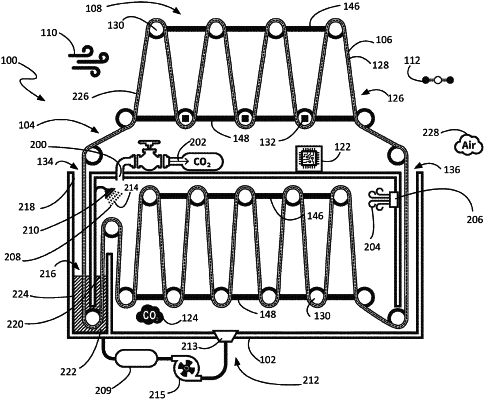| CPC B01D 53/08 (2013.01) [B01D 53/04 (2013.01); B01D 2257/504 (2013.01); B01D 2259/4009 (2013.01); B01D 2259/40086 (2013.01); B01D 2259/40092 (2013.01)] | 19 Claims |

|
1. A system for passive collection of atmospheric carbon dioxide, comprising:
a harvest chamber comprising a first opening and a sorbent regeneration system comprising a release medium, a release medium emitter, and a liquid extractor;
a capture body coupled to and movable by a support structure, the support structure having at least a first portion inside of the harvest chamber and a second portion outside of and above the harvest chamber at a height, the capture body comprising a sorbent material and movable by the support structure to be in a collection configuration wherein at least a portion of the capture body able to capture carbon dioxide is in contact with a natural airflow outside the harvest chamber such that atmospheric carbon dioxide is captured by the sorbent material, and a release configuration wherein at least a portion of the capture body holding captured carbon dioxide is in contact with the release medium inside the harvest chamber such that captured carbon dioxide is released into the harvest chamber to form an enriched gas;
a product outlet in fluid communication with the inside of the harvest chamber and configured to receive a product stream of enriched gas displaced by a sweep gas inside the harvest chamber, the sweep gas introduced to the harvest chamber; and
a control system communicatively coupled to the support structure, and configured to cycle the capture body through the collection configuration and the release configuration.
|
|
16. A method for passively collecting atmospheric carbon dioxide, comprising:
exposing at least a portion of a capture body able to capture carbon dioxide to a natural airflow, the capture body comprising a sorbent material that captures atmospheric carbon dioxide upon contact;
moving the at least a portion of the capture body holding captured carbon dioxide into a harvest chamber using a support structure coupled to the capture body and driven by a control system communicatively coupled to the support structure, the portion of the capture body holding captured carbon dioxide entering the harvest chamber through a first opening of the harvest chamber;
regenerating the sorbent material and releasing the captured carbon dioxide into the harvest chamber to form an enriched gas by exposing the sorbent material to a release medium introduced to the harvest chamber by a release medium emitter, the release medium being one of liquid water and steam;
extracting the release medium in liquid form from the harvest chamber using a liquid extractor;
removing a product stream of enriched gas from the harvest chamber through a product outlet by displacing the enriched gas with a sweep gas; and
removing the at least a portion of the capture body now having regenerated sorbent material from the harvest chamber by driving the support structure with the control system;
wherein an average flow rate across the first opening at a desired flow rate is maintained to create a dynamic air lock by operating at least one flow generator proximate the first opening using the control system and in response to a sensor reading from a sensor communicatively coupled to the control system, wherein the first opening is an open channel and wherein the sensor is one of a pressure sensor, a flow speed sensor, and a mass flow sensor.
|